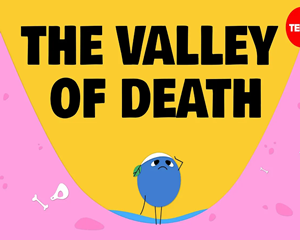They've passed every test, cleared every hurdle, jumped through every hoop. Now, all that remains is to unleash them on the world.
它们通过了每场测试、突破了所有障碍,跨越了每道坎。接下来所要做的一切就是将它们公诸于世。
But wait -- what's this? Ah, yes, there's one more challenge. They must now across the valley of death.
但是,等一下!这是什么?噢,对,还有一个挑战。它们现在必须要通过死亡谷。
All new products must pass through here before they reach the market.
所有新产品在推向市场前的必经之地。
Many never make it out, and sometimes that's OK -- if they don't work, don't fill a need, or for any number of other reasons.
许多产品在此跌倒后再没成功,有时候,这是可以理解的--比如有的产品不可用、没有满足需求,或者是其它一些原因。
But inventions that could help address massive global issues also face this risk.
但那些能帮助解决世界难题的研发产品也同样会面临类似的窘境。
That's because a technology's potential isn't the only factor that determines whether it will succeed.
因为技术潜力并不是决定产品能否成功的唯一因素。
The valley of death is especially risky for innovations involving complex physical objects as opposed to software,
死亡谷尤为危险,尤其是不同于软件,包含复杂物理元件的发明,
and for those in highly regulated industries, like medicine, building materials, and transportation.
以及一些受到严格监管的行业,比如医疗、建材以及交通运输。
Regulations and other obstacles aren't inherently bad -- they're often designed to keep people safe
监管以及其它障碍的本意并不是阻挠新发明,而是为保障人类安全所设计的,
but they do tend to scare off investors, and that's what traps good ideas in the valley of death: their funding dries up before they can become profitable.
但确实它们会吓跑一些投资人,而这也是造成好点子最后夭折于死亡谷的原因:在研发产品开始盈利前筹集的资金已消耗殆尽。
One of the fields where this problem is most pressing today is zero-carbon technologies.
现在受此现象影响较大的领域之一是零碳技术。
They're essential to our future because they will help us eliminate greenhouse gas emissions and stabilize our climate.
它们对我们未来的发展非常重要,因为它们能够减少温室气体的排放,稳定地球气候。
But they also have features that make them particularly vulnerable in the valley of death.
但是零碳技术本身在面对死亡谷的时候,也有致命弱点。
Let's look at why that is, and how we can change it. All new technologies must go through a development phase before they can become profitable.
让我们探究一下为何会出现如此现象,以及我们如何去改善这些薄弱点。所有的新兴技术在开始盈利前都会经过一个开发阶段。
For zero-carbon technologies, the costs of this phase are high, the timelines are long,
对于零碳技术来讲,在开发阶段里投入成本很高、耗时长,
and, in spite of the good they can do, demand is often low because they can require big changes in both infrastructure and consumer behavior.
而且除了技术对环境的正面影响,市场需求其实很小,因为它们对于基础设施以及消费习惯的要求,市场需要做出极大改变。
For example, electric heat pumps don't burn fossil fuels and, when you factor in savings on energy use, are cost-competitive with gas furnaces,
比如,电热泵不燃烧化石燃料,而且从能源使用节省的角度考虑时,电热泵与燃烧煤气的成本相似,
but homeowners only change their heating and cooling systems every few decades.
但是对居民而言,加热和制冷系统往往几十年才更换一次。

Direct air capture technologies, meanwhile, remove CO2 directly from the atmosphere.
而此时,直接空气捕获技术能够直接把二氧化碳从大气中移除。
We need these technologies to reach our emissions goals, and several of them have already been proven to work,
我们需要这些技术去达成我们的排放目标,有些技术也已经被证实有效,
but they're at risk of getting trapped in the valley of death because they're expensive.
但因为费用高昂,但它们仍有可能被腰斩在死亡谷里。
This creates a vicious cycle because the best way to lower costs is by, well, practicing: making more of a product and refining it.
这就形成了一个恶性循环,因为降低成本的最佳方式是实践:充分挖掘一个产品并且不断对其进行改进。
But high initial costs scare off investors, and without their money, companies can't continue to develop their technologies -- and can't ultimately decrease costs.
但是高昂的启动资金会吓跑投资者,没有了他们的投资,于是这些公司就无法继续研发它们的技术,因此最终的产品使用成本也不会降低。
Fortunately, there's a way to break this cycle:
但是幸运的是,有一个方法可以打破这个循环:
governments can help close the gap, when private investors won't fund technologies with such a high potential for social benefit.
政府可以介入来填平这个坑,尤其是当私人投资人不会对具有高社会回报率的技术进行投资的时候。
This isn't just theoretical: in the 1990s, functioning solar panels existed, but weren't widely adopted because of their cost.
这并不仅存在于理论层面:在上世纪90年代,功能太阳能电池板问世,但是由于它们的使用成本高,市场渗透率很低。
To change this, Germany offered government loans to companies creating solar panels,
为改善这一情况,德国政府向制造这些太阳能电池板的公司提供贷款,
and legally obligated utility companies to buy electricity produced using renewable energy.
并且在法律上强制公用事业企业去购买这些利用可再生能源产生的电力。
The U.S. and China followed suit by financing major solar panel projects.
美国与中国政府也随之资助大型太阳能电池板项目。
The cost of solar has dropped almost 90% since 2009, making it much easier to adopt.
从2009年开始,太阳能的成本下降了近乎90%,从而促进太阳能的推广。
A similar thing happened for wind energy: during the oil crisis of the 1970s, Denmark invested in wind power and started taxing winds' fossil fuel-based competitors.
这同样也适用于风能:在上世纪70年代的石油危机中,丹麦投资了风能并且向风能的竞争者化石燃料征税。
Other countries took similar steps, and as more wind power was generated worldwide, the costs of this technology dropped dramatically.
其它的国家也采取了类似举措,于是世界上越来越多的地方开始生产风能,这项技术的成本也大幅下降。
These success stories tell us that government initiatives work -- initiatives like boosting spending on research and development,
这些成功案例告诉我们政府的积极倡议是有用的,比如增加对于研发的开支;
offering tax and loan incentives to startups that want to develop zero-carbon technologies and consumers who want to buy them, and putting a price on carbon emissions.
面向开发零碳技术的创业公司以及有购买需求的消费者提供税收和贷款优惠政策;为碳排放明码标价,以向排放组织收取费用。
We need governments to do what they did for solar and wind for many more innovations.
我们需要政府为更多的创新发明做出它们推广太阳能和风能时的举措。
At the end of the day, ideas and inventions alone can't solve our most daunting problems
到头来,单凭创意和发明本身不能解决现今最艰巨的问题,
policies and markets have to be shaped so the most promising technologies can succeed.
要使最具潜力的技术获得成功,塑造适宜的政策和市场环境为当务之急。


